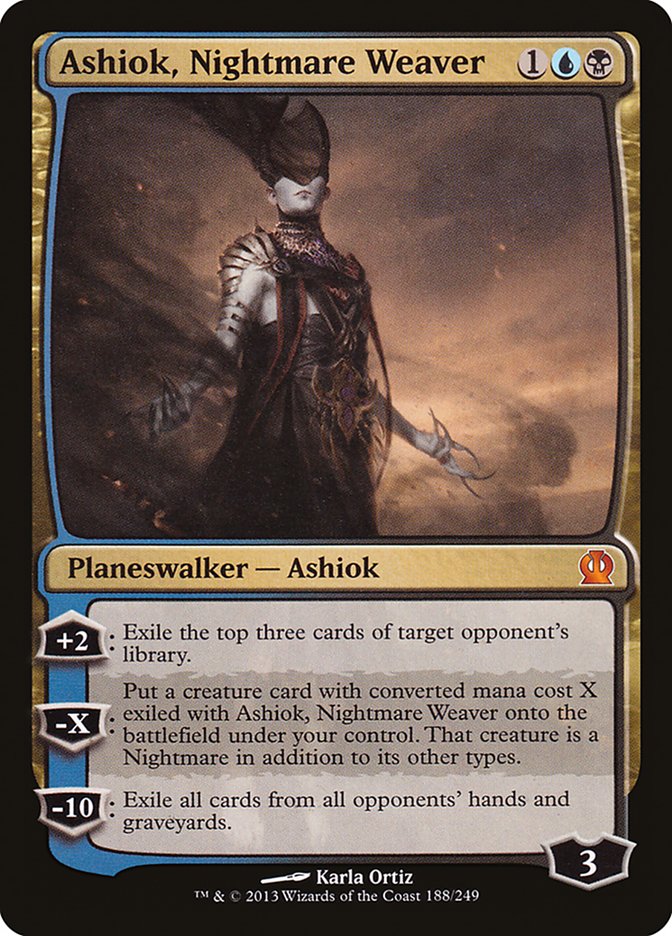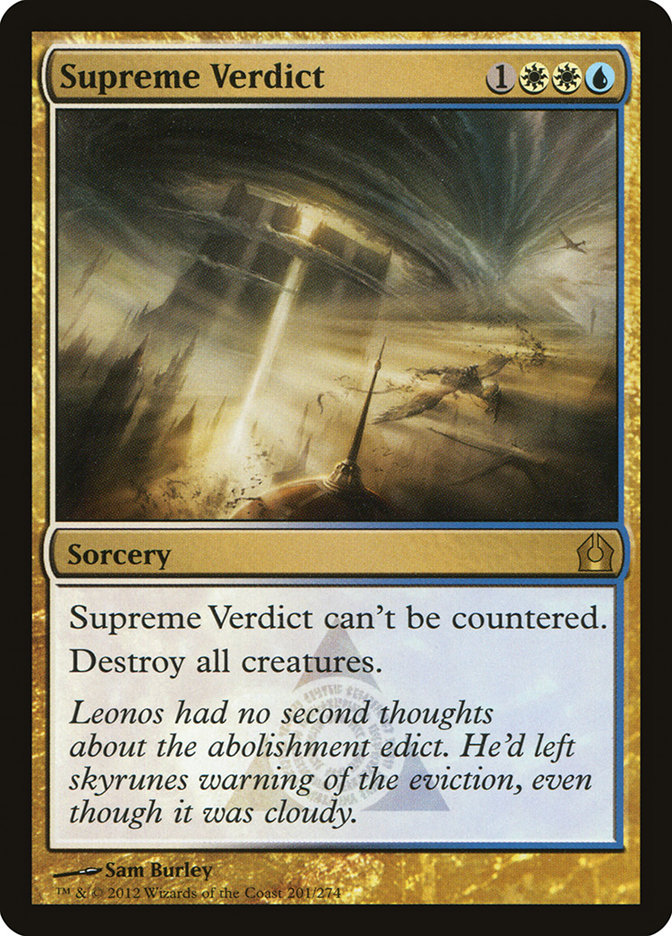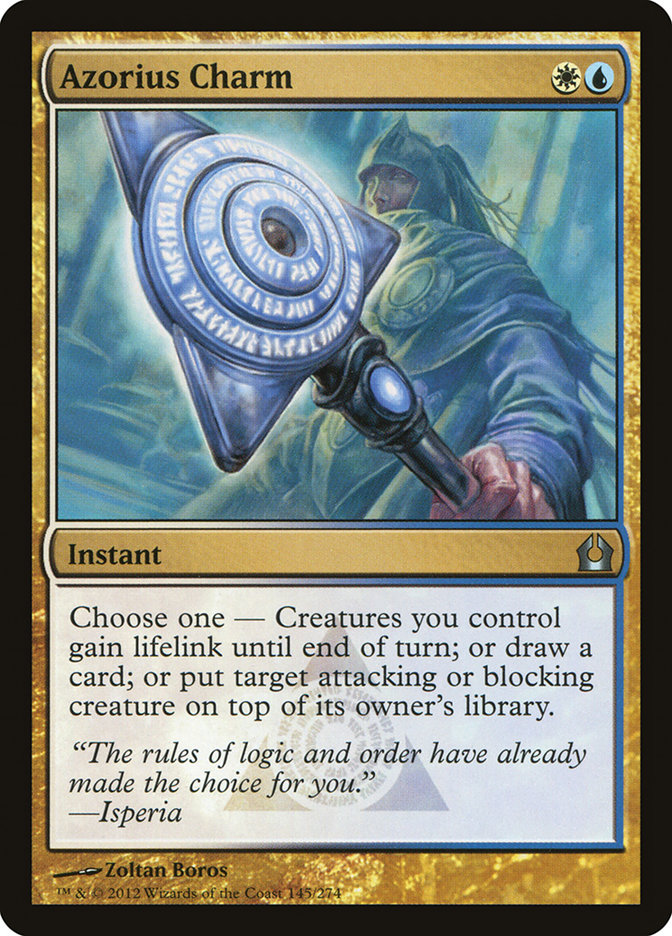With the release of Theros on the horizon and everyone clamoring for new ideas for Standard, today we’re going to continue our trek. While I haven’t played a ton with the new cards just yet (as I missed the Prerelease), I have a decent understanding of what’s going to be good and a few ideas about what’s going to be great.
This week, we’ll be going over Standard with a fine-toothed comb, looking for the beast to call our own. There is a gigantic list of cards that got much better with the rotation of Innistrad block, and there are a few sleepers that you should probably know about in the coming weeks.
So let’s get started, shall we?
Let God Sort ‘Em Out
I don’t want to set the world on fire
I just want to start
A flame in your heart
I’ve been thinking a lot about red decks lately. Whether it’s aggressive, midrange, or even control, red just feels good. Maybe I’m just a softie when it comes to Shock, but a world where Shock is playable is a world I’m just fine with.
With burn spells being both removal and doming material, red is actually pretty flexible. Sure, not every burn spell will match up well against the creatures being thrown at you, but you will also never have a dead card stuck in your hand when your reactive spells can turn the corner. The biggest hurdles facing red at the moment all come from G/W, but I think we can build a deck to beat those threats. Loxodon Smiter and Voice of Resurgence can be problematic, as well as Unflinching Courage and Trostani, Selesnya’s Voice out of the board, but I’m not sure those decks will be very well positioned with Supreme Verdict on the rise.
While I don’t have a “best list” or even a finely tuned list for any sort of red deck, I do know some interactions that I’m excited about.
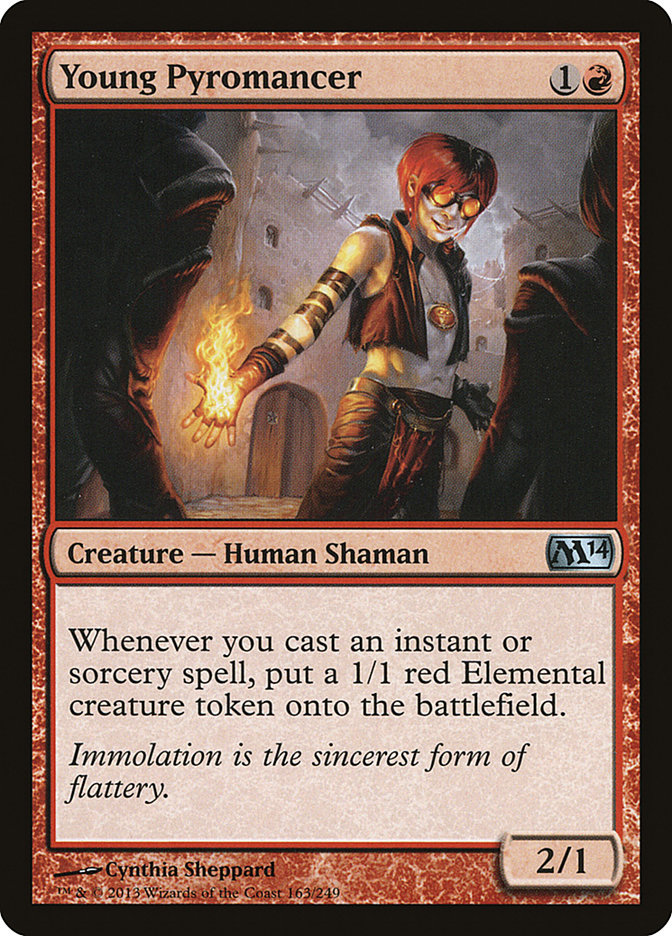 |
+ |
 |
For one, this combination is going to be popular in a variety of red-based strategies. Burn spells are pretty universal, and Young Pyromancer goes a long way toward making those spells much better. I know I’ve said it before, but Purphoros is going to be awesome with a reasonable list of cards. Young Pyromancer is probably number one or two on that list. The fact that you can play this combo in a control or aggro shell makes me very happy.
Whether you want to focus on turning Purphoros into a creature or just abuse his other abilities, he’s going to be powerful. I know this might be premature, but he’s my pick for best God of the bunch. When you start to churn out a swarm of tokens, things get ugly. Just thinking about Assemble the Legion with Purphoros . . .
You saw my Boros midrange list a few weeks ago (though it’s now archaic due to an incomplete spoiler), as well as an aggressive shell last week featuring Burning-Tree Emissary and Firedrinker Satyr. Both feature the duo of Purphoros and Young Pyromancer, but they are trying to do vastly different things. I’m giddy with anticipation to find out which one ends up being the best, but I can assure you one thing:
The land will continue to burn.
Drawing Cards & Tapping Out
Last week, I asked you guys to post your brews in the comments section of my article. It was inspiring to see so many people interested in what I had to say—and also a little overwhelming. I think I replied to about 60 or so decklists (maybe more?) and did my best to help you guys move in the right direction. Obviously, that isn’t to say that I’m correct in my assessments, but those suggestions were made in earnest. I would love nothing more than for my advice to help you crush your local tournament!
With that said, there were a few trends that I saw people moving towards, and I want to start off by saying a few things about Divination and Read the Bones.
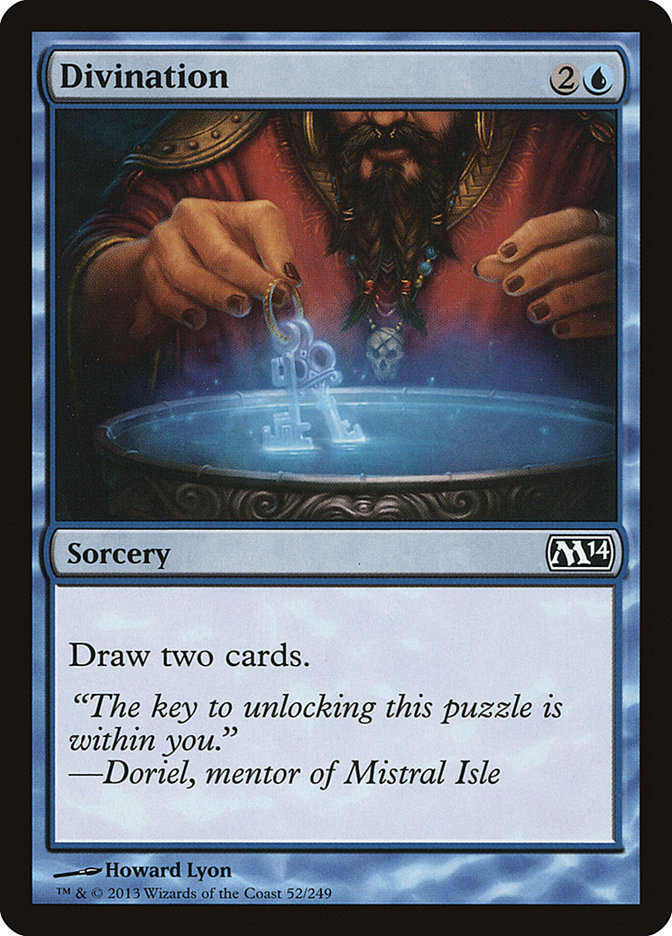 |
vs. |
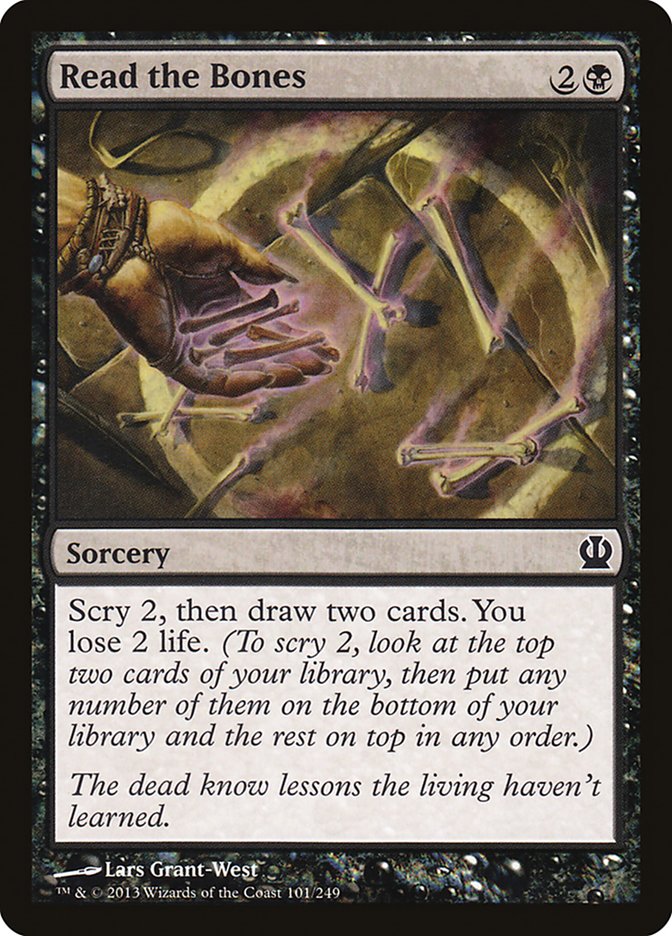 |
First of all, Read the Bones is not a card you want to play with when you have access to blue mana. You are basically paying two life for the cost of scry 2 when you could just as easily play Divination. Just because something is new doesn’t mean it is better than something old or even all that good to begin with.
Yes, I think Read the Bones is a playable card. I don’t like it myself, but I understand the necessity of such a card in a midrange or control deck without a lot of ways to gain card advantage. That doesn’t mean I have to want to play with it. I barely thought Sign in Blood was playable, and Read the Bones isn’t even on the same level.
But think about it. When you have the ability to play Divination in your midrange or control deck, opting to pay two life for an ability that doesn’t actually do all that much is absurd! If you’re playing a deck that wants a Divination effect, you likely need to hit all of your land drops to function properly. On top of that, your life points matter so much more in a world without Thragtusk, even more so when you have to play twelve lands that deal you two damage just to hit your curve.
The biggest argument for Divination is that a lot of people want to play Read the Bones. I’m under the impression that Divination will actually be one of the better cards for a lot of blue strategies because we no longer live in a world with Think Twice. We don’t have the luxury to gain card advantage and keep up countermagic, but we still need to draw cards. For this reason, it might be a stronger strategy to play tapout Magic rather than draw-go Magic.
Cast your spells. Hit your land drops. Play some answers and some bombs.
Play Divination.
Creatures (5)
Planeswalkers (6)
Lands (26)
Spells (23)
- 2 Syncopate
- 4 Divination
- 2 Ratchet Bomb
- 4 Azorius Charm
- 4 Supreme Verdict
- 3 Detention Sphere
- 2 Sphinx's Revelation
- 2 Dissolve
Sideboard

Ashiok, the Unplayable?
Did you know that when Jace Beleren was first printed, most people thought it was a joke? He was considered the worst planeswalker of the group and was often pushed aside as a worse Divination. He generally drew a single card before getting trampled on by basically any amount of pressure.
By the end of his existence in Standard (and eventual reprinting), he was put above the rest of the planeswalkers by a wide margin. It wasn’t even close. And I’ll tell you exactly why.
He had a huge effect on the game for just three mana.
In a world where the rest of the planeswalkers you have access to all cost four or more mana, three means a world of difference. Being able to apply that kind of pressure to any deck for a paltry three mana was absurd. Three was ridiculous.
Three was a dream.
And then came Liliana of the Veil, who demonstrated just how a three-mana planeswalker could absolutely dominate both Modern and Legacy.
She could kill creatures and deny resources to the opponent, and her ultimate was devastating in a lot of situations. But let me ask you one question about Liliana of the Veil that you might have to think about.
How many abilities does Liliana of the Veil have?
.
.
.
.
If you said three, I’ve got some bad news for you. Obviously, there are three abilities printed on the card. There are three abilities that you can choose between . . . when you are actually choosing to use one of those abilities.
The correct answer is four.
You can choose to do nothing with Liliana, which is important when you don’t actually want to discard any of the cards in your hand. You can wait until you have something a little bit worse to discard or even just let her sit there, content to protect you from an eventual Geist of Saint Traft.
I bring up this point for one reason and one reason alone. It is very easy to misjudge a card based on what is printed on it.
If you take this card at face value, looking only at what it does on paper, you might think it’s pretty mediocre. It doesn’t kill creatures. It doesn’t draw cards. It can’t really protect itself from an onslaught of creatures. These are characteristics that we focus on when determining just how powerful a blue planeswalker can be.
But for Ashiok, we might need to think outside the box a little bit.
The Millstone ability is reasonable. As a spell that continually eats away at your opponent’s library, it is not something to be ignored. Similarly, the ultimate from Ashiok can cancel out all the card advantage gained by an opposing control deck, as there is no way to Sphinx’s Revelation around it. These abilities shine against decks that can’t directly attack Ashiok and rely on tools such as Detention Sphere to contain it.
But the best ability—and by far the one most overlooked—is the fact that Ashiok can play creatures for free.
Think about that for a moment. Let it sink in. A control deck gets access to a planeswalker for three mana that can eventually start casting very good creatures for zero mana or just act as a win condition. When you start to combine removal spells or (gasp!) blockers, Ashiok actually starts to become appealing.
But one thing you probably forgot about in this whole rant is that Ashiok can come into play with five loyalty on the first turn. Outside of a red deck, it can be incredibly difficult to deal that much damage in the early turns of a game. And if they aren’t able to kill Ashiok immediately . . .
I will be the first one to say that untapping with an Ashiok will almost always be game over. It might not seem like that much on the surface, but we’re talking about a control deck. You get to use all your time and resources over the subsequent turns killing the various threats people keep throwing at Ashiok.
And if you get to play a blocker for free off of the –X ability . . .
Ashiok creates a snowball effect that will make it harder and harder for the opponent to kill it. If you even get one creature from the ability, let alone two, the mana investment is so low for the resources your opponent had to put into killing it that it is no longer difficult to realize just how good Ashiok can be.
With all of that said, the shell around Ashiok will be the most difficult part to figure out. Three colors will make the prospect of casting it on turn 3 rather difficult, but you get so many absurd tools when adding white that it seems foolish not to consider.
You can take my word on this one; Ashiok will be the biggest sleeper in the set and is my pick for breakout card at the Pro Tour.
Wescoe Check
If you know anything about Craig Wescoe, you know that he has an affinity for white creatures. In basically every format, he wants to jam Glory Seeker as much as possible, but I think that this format is actually primed for a white aggressive deck to be dominant again.
Supreme Verdict aside, white decks are usually pretty legit. They have an aggressive curve and a few tricks up their sleeves to punish the ill prepared. The reprinting of Brave the Elements has only made the archetype better, giving you a versatile bomb that can act as a Dispel against spot removal on top of giving you the ability to get all your creatures through a stalled board. And with Anger of the Gods being all the rage, it can even protect your team from a genuine board sweeper.
With two different creatures acting as Savannah Lions proxies, it is possible to have a curve that is equally as aggressive as most red decks. And with access to a new Glorious Anthem in Spear of Heliod, all the chips seem to be falling into place.
I’m not that picky when it comes to aggressive decks, but I like to be prepared for a wide variety of answers. Supreme Verdict seems to be the most tricky one to get around at the moment, as it can effectively trump most of your aggressive starts before you get the opponent actual-factual dead. You don’t have many ways to gain card advantage against the control decks, so you need your spells to hit pretty hard and have flexibility.
With that in mind, I built a nifty little White Weenie deck featuring everyone’s favorite Charm.
Creatures (25)
- 4 Dryad Militant
- 4 Precinct Captain
- 4 Boros Reckoner
- 3 Banisher Priest
- 4 Imposing Sovereign
- 2 Heliod, God of the Sun
- 4 Soldier of the Pantheon
Lands (24)
Spells (11)

This is an aggressive deck that can punish a wide variety of spells that are naturally designed to foil aggressive strategies. Many of your spells function on two different levels and have the ability to be aggressive or defensive given the particular situation. Early in the game, Soldier of the Pantheon can act as a very aggressive threat and also poses problems for things like Loxodon Smiter and Voice of Resurgence. The same can be said about Boros Reckoner and Precinct Captain, which are both fantastic at playing defense but hit pretty hard in their own right.
The flip side of those threats is that they’re both awesome alongside Spear of Heliod as well as Heliod himself. You can dominate the board, creating a creature stall if you so choose, and make your threats much bigger than theirs while positioning yourself to steal late games with things like Brave the Elements.
You can also just beat the hell out of your opponent before they can get on even footing.
Imposing Sovereign is something I want to try out, though I’m not sold that it is better than Daring Skyjek. It is pretty difficult for your opponent to profitably block many of your creatures to begin with, so a three-power creature might be exactly what you want, but I have a feeling that it will be fairly common for your opponent to throw up some roadblocks for your aggressive draws. Imposing Sovereign helps make them less of a problem while also supplying a reasonable body. The fact that it helps keep haste creatures in check is also a plus, though it will be much less relevant without Hellrider in the format.
Boros Charm does a lot of things well in this deck. Supreme Verdict is one of the biggest problem cards you will face, and it does a great impression of Counterspell in those scenarios. On top of that, you can actually just kill your opponent with it. Like always, the double-strike option won’t come up too often since you don’t have a lot of ways to make your creatures gigantic. With that said, the two modes used most often are still good enough for this type of deck and worth splashing for.
Banisher Priest is a card you will want to draw a million of in some matchups and absolutely hate against decks without creatures. Luckily, it attacks for two, unlike his predecessor Fiend Hunter, though I am still not excited about the prospect of playing Grey Ogre. Fortunately, it is disgusting alongside Brave the Elements and makes some of your draws against other aggro decks unbeatable.
The sideboard is mainly focused on attacking other aggro and midrange decks, though you have options against virtually all possible opponents. Assemble the Legion and Rootborn Defenses aren’t aggressive in matchups where you need to be aggressive, but they are tools designed to help you defend against some of the stronger cards versus your deck. Both are great going long against Supreme Verdict decks, but neither is good in the early turns of a game. This is something you might have to live with if U/W Control ends up being one of the most popular archetypes early on.
Mizzium Mortars, along with the additional Boros Guildgate (which could be a Mountain), is your answer to Blood Baron of Vizkopa or just additional removal against all the big dumb green decks. They’re going to brick wall you a lot of the time with Loxodon Smiter, and this helps clear the path. You could argue for Pacifism or something similar, but I am a fan of Mizzium Mortars in a deck that has no actual other way to beat Blood Baron. You won’t overload Mizzium Mortars often, but the potential is there if you can stall your opponent long enough with Boros Reckoner and the rest of the squad.
I’m not exactly sure where I want to be with this deck honestly. You can play the beatdown role when it is necessary and the control role when the time comes, but it might be better to just go all in one way or another. The extremes aren’t always where you want to be in a fledgling format because their holes are fairly easy to exploit. This deck, on the other hand, is pretty good at fighting a bunch of different fights at once.
It just has a little trouble against Supreme Verdict.
Opening Day
This coming weekend marks the grand debut for Theros in Standard with the SCG Open in Worcester. While I won’t be attending due to it being double-digits in the hours-driven department, I will be watching as new decks crop up and old favorites try to hold their own. We have a lot of data to work with since the majority of the format is Return to Ravnica block, but it will be awesome to see just how powerful/overrated/underrated some of the cards end up being.
Personally, I’m hoping Ashiok finds a decent home, and I wouldn’t be surprised if someone builds a sweet Dimir or Esper deck to take full advantage of the new planeswalker. At the very least, I would want some sweet combo deck to take the forefront, though I don’t foresee any Obzedat’s Aid decks taking the reins from Scavenging Ooze.
Thanks for reading.
Todd Anderson
@strong_sad on Twitter
strong sad on Magic Online


